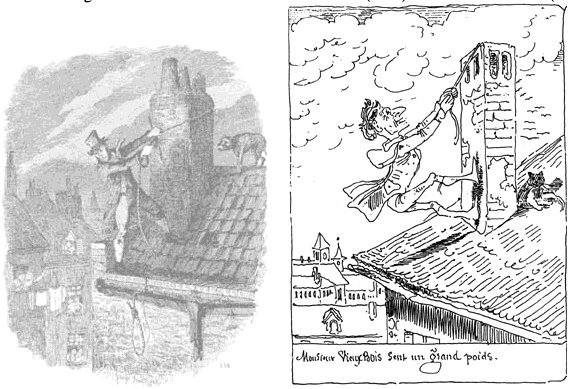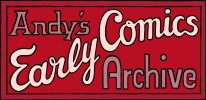"The Last Chance"
George Cruikshank's illustration for Oliver Twist (1939)
and
Mr Vieux Bois (1839 version)

(Sent to the Platinum Comics mailinglist by Thierry Smolderen)
Rodolphe's father, Adam, who was an excellent caricaturist in the english
tradition, made a trip to england (during Rodolphe's youth) and evidently
brought back some material from there. The influence of Rowlandson is
particularly visible in the aquatint by Adam Toepffer . The Toepffers were
anglophiles in a town (Geneva) where a lot of rich englishmen visited, and I
guess there was a constant flux of books between the capitals of Europe, as
book were (and still are), the perfect token of friendship from individual
to individual.As someons said in this thread, it's probably safe to take for
granted that most of the actors concerned by political caricature,
illustrated books, printed sketchbooks, picture-novels etc. where aware of
each other's work.
There is a tantalizing Toepffer-Cruikshank-Grandville triangle of reciprocal
influence (Cruikshank's career of course, was long enough to permit early
influence on someone that he would later be influenced by). I submit this to
you all (I'll try to check it out myself at the CNBDI this afternoon) :
- one image is from the 1839 edition of Mr Vieux Bois : it shows Mr Vieux
Bois on a roof, escaping from jail : notice the general framing, the
chimney, the rope, the dog.
- all these elements are found in one of Cruishank's best known
illustrative work for Oliver Twist : Sike's escape ("The last chance"),
also published in 1839.
All the elements are there : the dog, the chimney, the rope, the escape
theme, the framing etc.
It could be a coincidence, of course. Or maybe there is a "third party"
influence. Anyway, here's is what Vogler writes about this image in
"Graphics Works of George Cruikshank" (Dover) :
"The Last Chance : After Dickens had written the text for this
illustration, he wrote to Cruikshank "that the scene of Sikes' escape will
not do for illustration. It is so very complicated, with such a multituyde
of figures, such violent action and torch-light to boot, that a small plate
could not take in the slightest idea of it". Notwhistanding this comment,
the artist was able to catch in roughly a four-by-four-inch etching a great
deal of the atmosphere surrounding Sikes' escape. Although the crowd below
is not shown, its presence and mood are sensed and the dynamics of the scene
felt because the window watchers and the expression on Sikes' face. The
theme of hanging isdramatically foreshadowed in this scene as are the theme
s of confinement and suffocation in the next."
Now, the catch : according to Thierry Groensteen's preface of the Mr Vieux
Bois reediton for le Seuil, the 1839 edition of Mr Vieux Bois was revised in
depth by Töpffer so as to distance his work from pirates copies.
Was this scene in the original version (so pre-dating Cruikshank's version),
or was it a new adjunction ?
I favor the first hypothese (Cruikshank was influenced by Toepffer), but
maybe those of you who have the pirated versions could check.
This is of importance to me, because the fact that Cruikshank would have
used a typically slapstick sequence by Toepffer as a model for an action
that Dickens saw as impossible to represent in a four-by-four-inch etching
would show that at least in his these action or slapstick scenes, Toepffer
was exploiting a new graphical-space that held useful solutions for
illustrators.
Thierry Smolderen
|
|
